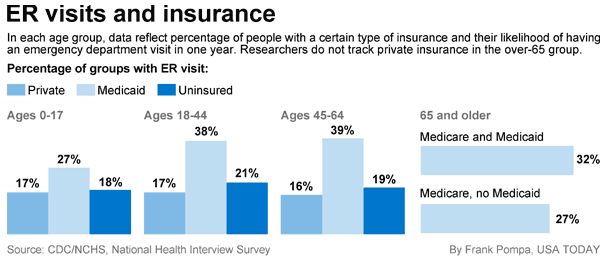Headlines
As reported by USA Today, May 19, 2010.
Study: Uninsured Don't Go to the ER More Than Insured
By Mary Brophy Marcus

A kiss gone awry isn't the typical route that lands a person in the emergency room, but that's just how Maggie Craytor ended up in the University of Virginia Medical Center's emergency department in August.
"She was running after her older brother Luke to give him a kiss, and she fell and got a cut right underneath her eye," says her mother, Allison. Maggie, now 4, needed two stitches. Her mother is glad the family had insurance to cover the costly emergency visit her pediatrician's office recommended.
The Craytors, a family of five with private health insurance, are just as likely to use the emergency room as people without insurance, according to a new report by the Centers for Disease Control and Prevention.
The aim of "Emergency Department Visitors and Visits: Who Used the Emergency Room in 2007?" was to determine the types of visitors who use hospital ERs.
The results may surprise some who believe that ERs mainly serve uninsured people, says second author Amy Bernstein, chief of the Analytic Studies Branch in the Office of Analysis and Epidemiology for the CDC and the National Center for Health Statistics.
"We were trying to show characteristics of people who use the ER. There are some perceptions. ... A lot of people think it's predominantly used by uninsured people because they don't have a normal source of primary care, but this particular brief shows this is not the case," Bernstein says.
The total number of ER visits in 2007 was 116,802,000, Bernstein says, and one in five Americans have been to the ER in the past year.
Sometimes Impatience Is a Factor
The researchers looked at the age and race of ER visitors as well as the type of insurance they use and whether they had none at all, Bernstein says.
The key findings:
- ER visits by the uninsured were no more likely to be triaged as non-urgent than visits by privately insured patients or those with Medicaid coverage.
- Older adults, African-Americans, poor people and those on Medicaid were more likely to have had at least one visit in a 12-month period than others.
- Medicaid-covered patients were more likely to have multiple visits in a 12-month period than privately insured and uninsured patients.
- People with and without a usual source of medical care were equally likely to have had one or more ER visits in one year.
The findings that older, sicker people are more likely to use the ER and that insurance or lack of insurance doesn't matter are not surprising, says Angela Gardner, president of the American College of Emergency Physicians.
"People come to the ER when they need to come to the ER," she says.
One of the factors that drives people to an ER that has nothing to do with insurance is an impatience to have a non-severe problem evaluated, says Robert Fuller, clinical chief of emergency medicine at John Dempsey Hospital, University of Connecticut Health Center and School of Medicine.
"ERs offer same-day service," he says.
But sometimes a doctor may have malpractice concerns, Fuller says, which also can send patients to the ER: "Primary-care doctors can be risk-averse and have a tendency to send more patients to emergency departments rather than triage and advise over the phone."
Sometimes the ER Is Just Faster
Kat Stein, 44, a mother of two from Philadelphia, wonders about her primary-care doctor's actions. Stein said she visited her doctor for chest pain in January and was prescribed drugs for sudden, adult-onset asthma. When the pain grew worse a few days later, her doctor couldn't see her right away.
"It felt like a brick was on my chest, so I waited in her office without an appointment. I sat for two hours," Stein says.
Eventually, she asked the office staff and they agreed she should go to the ER. Stein headed to nearby Thomas Jefferson University Hospital's ER, where she was diagnosed with a serious but treatable heart condition.
That Medicaid patients use the ER more regularly is predictable, says Frank McGeorge, a senior staff physician in the ER at Henry Ford Hospital in Detroit, whose ER sees a high rate of Medicaid patients — 34%.
"High Medicaid utilization is no surprise, many patients have difficulty finding primary-care providers who take Medicaid, so the ER is the only alternative," McGeorge says.
Gardner says there's one major caveat to the new report. "All of this is 2007 data, before the market crashed, before the economy went south, and before health reform. So how useful is it?"


